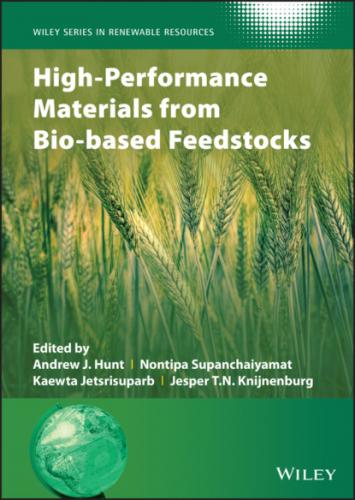14 14. Elyounssi, K., Collard, F.X., Mateke, J.N. et al. (2012). Improvement of charcoal yield by two‐step pyrolysis on eucalyptus wood: a thermogravimetric study. Fuel 96: 161–167. https://doi.org/10.1016/j.fuel.2012.01.030.
15 15. Erçin, D. and Yürüm, Y. (2003). Carbonisation of Fir (Abies bornmulleriana) wood in an open pyrolysis system at 50–300°C. Journal of Analytical and Applied Pyrolysis 67 (1): 11–22. https://doi.org/10.1016/S0165‐2370(02)00011‐6.
16 16. Kato, Y., Enomoto, R., Akazawa, M. et al. (2016). Characterization of Japanese cedar bio‐oil produced using a bench‐scale auger pyrolyzer. SpringerPlus 5 (1): 177. https://doi.org/10.1186/s40064‐016‐1848‐7.
17 17. Nanda, S., Mohanty, P., Pant, K.K. et al. (2013). Characterization of North American lignocellulosic biomass and biochars in terms of their candidacy for alternate renewable fuels. BioEnergy Research 6 (2): 663–677. https://doi.org/10.1007/s12155‐012‐9281‐4.
18 18. Pedersen, T.H., Grigoras, I.F., Hoffmann, J. et al. (2016). Continuous hydrothermal co‐liquefaction of aspen wood and glycerol with water phase recirculation. Applied Energy 162: 1034–1041. https://doi.org/10.1016/j.apenergy.2015.10.165.
19 19. Grima‐Olmedo, C., Ramírez‐Gómez, Á., Gómez‐Limón, D. et al. (2016). Activated carbon from flash pyrolysis of eucalyptus residue. Heliyon 2 (9): E00155. http://dx.doi.org/10.1016/j.heliyon.2016.e00155.
20 20. Ekhlasi, L., Younesi, H., Rashidi, A. et al. (2018). Populus wood biomass‐derived graphene for high CO2 capture at atmospheric pressure and estimated cost of production. Process Safety and Environmental Protection 113: 97–108. https://doi.org/10.1016/j.psep.2017.09.017.
21 21. Ilnicka, A., Kamedulski, P., Aly, H.M. et al. (2020). Manufacture of activated carbons using Egyptian wood resources and its application in oligothiophene dye adsorption. Arabian Journal of Chemistry 13 (5): 5284–5291. https://doi.org/10.1016/j.arabjc.2020.03.007.
22 22. Wang, X., Liu, Y., Zhu, L. et al. (2019). Biomass derived N‐doped biochar as efficient catalyst supports for CO2 methanation. Journal of CO2 Utilization 34: 733–741. https://doi.org/10.1016/j.jcou.2019.09.003.
23 23. Chen, W., Fang, Y., Li, K. et al. (2020). Bamboo wastes catalytic pyrolysis with N‐doped biochar catalyst for phenols products. Applied Energy 260: 114242. https://doi.org/10.1016/j.apenergy.2019.114242.
24 24. Qian, K., Kumar, A., Bellmer, D. et al. (2015). Physical properties and reactivity of char obtained from downdraft gasification of sorghum and eastern red cedar. Fuel 143: 383–389. https://doi.org/10.1016/j.fuel.2014.11.054.
25 25. Wang, S., Dai, G., Yang, H. et al. (2017). Lignocellulosic biomass pyrolysis mechanism: a state‐of‐the‐art review. Progress in Energy and Combustion Science 62: 33–86. https://doi.org/10.1016/j.pecs.2017.05.004.
26 26. Shen, Y. (2018). Rice husk‐derived activated carbons for adsorption of phenolic compounds in water. Global Challenges 2 (12): 1800043. https://doi.org/10.1002/gch2.201800043.
27 27. Steurer, E. and Ardissone, G. (2015). Hydrothermal carbonization and gasification technology for electricity production using biomass. Energy Procedia 79: 47–54. https://doi.org/10.1016/j.egypro.2015.11.473.
28 28. Rashidi, N.A., Yusup, S., Ahmad, M.M. et al. (2012). Activated carbon from the renewable agricultural residues using single step physical activation: a preliminary analysis. APCBEE Procedia 3: 84–92. https://doi.org/10.1016/j.apcbee.2012.06.051.
29 29. Biswas, B., Pandey, N., Bisht, Y. et al. (2017). Pyrolysis of agricultural biomass residues: comparative study of corn cob, wheat straw, rice straw and rice husk. Bioresource Technology 237: 57–63. https://doi.org/10.1016/j.biortech.2017.02.046.
30 30. Huff, M.D., Kumar, S., and Lee, J.W. (2014). Comparative analysis of pinewood, peanut shell, and bamboo biomass derived biochars produced via hydrothermal conversion and pyrolysis. Journal of Environmental Management 146: 303–308. https://doi.org/10.1016/j.jenvman.2014.07.016.
31 31. Rahman, M.M., Awang, M., Mohosina, B.S. et al. (2012). Waste palm shell converted to high efficient activated carbon by chemical activation method and its adsorption capacity tested by water filtration. APCBEE Procedia 1: 293–298. https://doi.org/10.1016/j.apcbee.2012.03.048.
32 32. Bader, N. and Ouederni, A. (2016). Optimization of biomass‐based carbon materials for hydrogen storage. Journal of Energy Storage 5: 77–84. https://doi.org/10.1016/j.est.2015.12.009.
33 33. Apaydın‐Varol, E. and Pütün, A.E. (2012). Preparation and characterization of pyrolytic chars from different biomass samples. Journal of Analytical and Applied Pyrolysis 98: 29–36. https://doi.org/10.1016/j.jaap.2012.07.001.
34 34. Lee, Y., Park, J., Ryu, C. et al. (2013). Comparison of biochar properties from biomass residues produced by slow pyrolysis at 500°C. Bioresource Technology 148: 196–201. https://doi.org/10.1016/j.biortech.2013.08.135.
35 35. González, J.F., Román, S., Encinar, J.M. et al. (2009). Pyrolysis of various biomass residues and char utilization for the production of activated carbons. Journal of Analytical and Applied Pyrolysis 85 (1): 134–141. https://doi.org/10.1016/j.jaap.2008.11.035.
36 36. Rezma, S., Birot, M., Hafiane, A. et al. (2017). Physically activated microporous carbon from a new biomass source: date palm petioles. Comptes Rendus Chimie 20 (9): 881–887. https://doi.org/10.1016/j.crci.2017.05.003.
37 37. Al‐Wabel, M.I., Rafique, M.I., Ahmad, M. et al. (2019). Pyrolytic and hydrothermal carbonization of date palm leaflets: characteristics and ecotoxicological effects on seed germination of lettuce. Saudi Journal of Biological Sciences 26 (4): 665–672. https://doi.org/10.1016/j.sjbs.2018.05.017.
38 38. Cai, J., Li, B., Chen, C. et al. (2016). Hydrothermal carbonization of tobacco stalk for fuel application. Bioresource Technology 220: 305–311. https://doi.org/10.1016/j.biortech.2016.08.098.
39 39. Tobi, A.R., Dennis, J.O., Zaid, H.M. et al. (2019). Comparative analysis of physiochemical properties of physically activated carbon from palm bio‐waste. Journal of Materials Research and Technology 8 (5): 3688–3695. https://doi.org/10.1016/j.jmrt.2019.06.015.
40 40.
